In Filipino folklore, an “aswang” is a shapeshifting demon, the monster parents use to frighten their kids. For director Alyx Ayn Arumpac, the aswang is a metaphor for the current state of the Philippines. How else to explain the 30,000+ extrajudicial killings since President Rodrigo Duterte declared his war on drugs?

A dark, despairing documentary, Aswang probes the aftermath of drug deaths in the slums of Manila. Arumpac adopts a stream-of-consciousness style that builds atmosphere from scattered incidents. She films mostly at night, as ambulances prowl alleys for corpses and addicts scavenge garbage. Flashlights pick out bodies sprawled on sidewalks. Bystanders flit away into the darkness.
Families come to the Eusebio Funeral Parlor, where bodies wait on gurneys or in coffins. Jun, a Redemptorist Missionary brother, hosts a “funeral assistance” program at a local church. He notes that area deaths have risen from one or two a week to three to five a day. “Why do these killings happen while we’re asleep?” he wonders.
Arumpac’s cameras single out Jomari, a six-year-old whose parents are in prison on drug sentences. His best friend Kian, a teenager, was killed on the streets. Now Jomari sleeps by heaps of garbage and fetid canals where he begs for food with other kids. They dream of becoming soldiers, rap stars, of moving to the country.
As a mother sweeps a pool of blood into a gutter, a man insists his brother was innocent. “I am for Duterte,” he says, “but what they did to my brother was wrong.” He’s echoed by witness after witness who rebut official police reports.
Aswang‘s unrelieved gloom can overwhelm viewers. The dirty alleys, piles of garbage, and dirt-floor hovels blur together until hopelessness sets in. Some of the more “poetic” images, like police tape fluttering in the wind, or congregants stroking a life-sized crucifix, feel like missteps.

But other moments are truly disturbing. Arumpac follows a funeral procession to a mass burial site where bodies are shoved into open stacks. Undertakers separate corpses with cinderblocks. At night the homeless sleep atop the graves.
In a police station, cameras uncover dozens of kidnapped citizens who had been trapped in a room hidden behind a filing cabinet. Unable to pay their ransoms, they were kept in the dark without food or water. While journalists watch, officials fabricate arrest records before sending them off to jail.
Arumpac and her crew filmed over a three-year period as the violence escalated. By waiting until police and reporters leave crime scenes, by letting the families speak for themselves, they can capture unfiltered some of the pain the killings cause.
Aswang screens at the Asian American International Film Festival in Los Angeles on October 11. The Danish distributor LevelK will open the documentary on digital platforms this fall.


